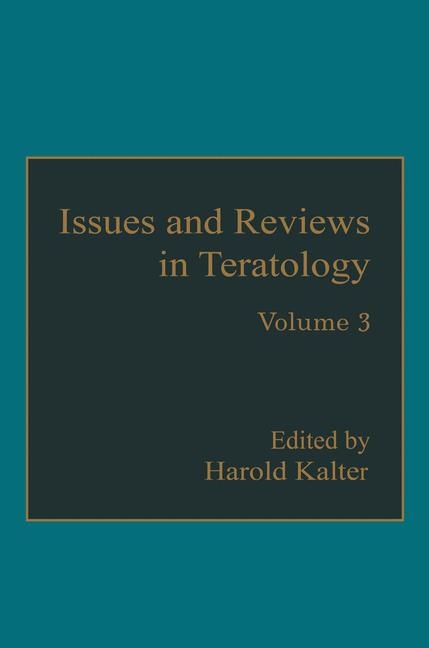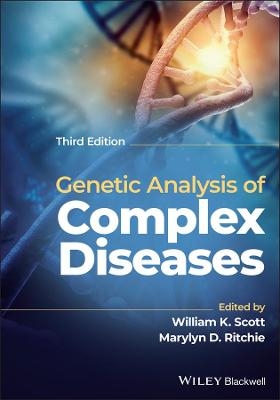
Issues and Reviews in Teratology
Kluwer Academic/Plenum Publishers (Verlag)
978-0-306-41988-1 (ISBN)
- Titel ist leider vergriffen;
keine Neuauflage - Artikel merken
There is still no clear understanding of what causes the great majority of human congenital malformations. And since in most sorts of human disease and pathology that yet prevail prevention usually awaits understanding of cause, it is generally thought that the same is true of developmental aberrations. But is this true? For the relatively few congenital malformations whose causes are primarily environmental, it is plain that their discovery has enabled prevention, but not nec- essarily immediately. It took a generation from the time of the discovery that maternal rubella was teratogenic to learn how to immunize against it. Much debate occurred before it was appreciated that thalidomide was a teratogen, and only its removal from the pharmacist's shelf and the end of the epidemic of limb defects attributed to the drug overcame the last doubts. For other proven environmental teratogens doubts and difficulties still con- tinue. The claimed prevalence of fetal genital distortions due to female sex hor- mones may have been exaggerated. Some potentially teratogenic therapeutic drugs, like anticoagulants, anticonvulsants, and anticancer chemicals, are still pre- scribed despite this danger because of their benefits to pregnant women. For those congenital malformations whose basis is predominantly genetic or chromosomal it is different, however. Prevention has not been achieved by the discovery of such causes, as dramatic and revolutionary as some of them have been, except in the questionable sense of interference with reproduction by genetic coun- seling or prenatal elimination. But this has not inhibited the romanticists.
1 The Role of the Obstetrician in the Prevention and Treatment of Birth Defects.- 1. Introduction.- 2. The Abnormal Conceptus.- 3. Causes of Birth Defects.- 4. Screening for Congenital Anomalies.- 4.1. Intrauterine Infections.- 4.2. Neural Tube Defects.- 4.3. Ultrasonography.- 5. Diagnosis of the Abnormal Conceptus.- 5.1. X-Ray.- 5.2. Ultrasound.- 5.3. Amniocentesis.- 5.4. Fetoscopy.- 5.5. Chorionic Villous Sampling.- 6. Management of the Abnormal Conceptus.- 6.1. Abortion.- 6.2. Fetal Surgery.- 7. The Future.- References.- 2 The Nature and Causes of Spontaneous Abortions with Normal Karyotypes.- 1. Introduction.- 2. Mechanisms of Abortion.- 3. Incidence of Chromosomally Normal Abortuses.- 4. Clinically Implicated Causes of Spontaneous Abortion.- 4.1. Infection.- 4.2. Immunological Factors and Spontaneous Abortion.- 4.3. Morphological Abnormalities.- 4.4. Abnormalities of the Uterine Environment and of Uterine Function.- 4.5. Endocrinological Factors.- 4.6. Maternal Disease and Spontaneous Abortion.- 4.7. Environmental Factors and Spontaneous Abortion.- 5. Summary.- 6. Conclusions.- References.- 3 Temporal Trends in Twinning.- 1. Introduction.- 2. Time Trends in Twinning Rates.- 2.1. Western Europe.- 2.2. Eastern Europe.- 2.3. United States.- 2.4. Canada.- 2.5. Japan.- 2.6. Other Countries.- 2.7. Summary: The Decline in Twinning in Recent Years.- 2.8. Variations in Twinning Rates over the Longer Term.- 2.9. Is the Drop in Rates Ending?.- 3. The Etiology of Twinning. Some Recent Findings.- 4. The Physiological Mechanism of DZ Twinning.- 5. Hypotheses Related to the Decrease in Twinning Rates.- 5.1. Age and Parity Distribution of the Maternal Population.- 5.2. The Differential Fecundability Hypothesis.- 5.3. Effects of Oral Contraceptives.- 5.4. Hypothesis of an Increase in Spontaneous Abortion.- 5.5. Decreased Sperm Counts or Sperm Quality.- 5.6. Coital Rates.- 5.7. Genetic Factors.- 5.8. Urbanization and Stress.- 5.9. Nutritional and Socioeconomic Factors.- 6. Conclusion.- References.- 4 Cytogenetic and Clinical Significance of Fragile Sites on Human Chromosomes.- 1. Introduction.- 2. Fragile Sites on Autosomes.- 2.1. Folate-Sensitive Fragile Sites.- 2.2. BUdr-Requiring Fragile Site 10q25.- 2.3. Fragile Site 16q22.- 2.4. Fragile Site 17pl2.- 2.5. Individual Folate-Sensitive Fragile Sites.- 2.6. Other, Not Yet Fully Accepted, Folate-Sensitive Fragile Sites.- 3. Fragile Site on the Human X Chromosome (Xq27).- 3.1. Hemizygotes.- 3.2. Heterozygotes.- 3.3. Cytogenetic Diagnostic Criteria.- 3.4. Amniotic Fluid Cell Cultures.- 3.5. Formal Genetics and Genetic Counseling.- 3.6. Location of the Fragile Site Mutation on the X Chromosome.- 4. X-Linked Mental Retardation without Cytogenetic Manifestation.- 5. Concluding Remarks.- References.- 5 Informative Morphogenetic Variants: Minor Congenital Anomalies Revisited.- 1. Background.- 2. Terminology; Definition.- 3. Quantification of Informative Morphogenetic Variants (IMV): Formal and Comparative Aspects.- 3.1. Properties of the Examination.- 3.2. Quality of the Examiners and Recording of Their Observations.- 3.3. Characteristics of the Population Examined.- 4. The Biology of Informative Morphogenetic Variation.- 5. The Specific and Nonspecific Value of Informative Morphogenetic Variants, Singly and in Combination.- 5.1. Single Informative Morphogenetic Variants.- 5.2. Combinations of Informative Morphogenetic Variants As Predictors, and Clues to the Temporal Origin and Pathogenesis of Defective Intellectual and/or Behavioral Development.- 6. The Use of Specific Aggregates of Informative Morphogenetic Variants for Diagnostic Purposes.- 7. The Application of Numerical Taxonomy to Informative Morphogenetic Variants for the Purposes of Classification and Nosology.- 8. Informative Morphogenetic Variants As Indices of Teratogenic Environments.- 9. How Can the Information Value of Morphogenetic Variants Be Increased?.- 9.1. Measurement of Graded Anthropometric Characters to Identify Informative Morphogenetic Variants.- 9.2. Recognition of Factors Affecting the Discriminative Value of Ungraded Informative Morphogenetic Variants.- 10. The Positive Prognostic and Dysmorphogenetic Significance of Informative Morphogenetic Variants.- 11. Informative Morphogenetic Variants As Components of Predictive Scores for Nonspecific Detection of Congenital Disorders Not Apparent at Birth.- 12. The Value of Informative Morphogenetic Variants in Late Childhood- or Adult-Onset Disease.- 12.1. Thoracic-Outlet Syndrome.- 12.2. Mitral-Valve Prolapse (MVP) Syndromes.- 12.3. Accessory Spleens.- 13. Informative Morphogenetic Variants As Sentinel Phenotypes for Monitoring Environmental Teratogenic Hazards in Populations.- 14. Summary.- 14.1. What Do We Know about Morphogenetic Variants That Is Useful Now?.- 14.2. What Do We Need to Know or Do to Increase the Informative Value of Morphogenetic Variants?.- 15. Epilogue.- References.- 6 The Mouse Trisomies: Experimental Systems for the Study of Aneuploidy.- 1. The Generation of the Mouse Trisomies.- 1.1. Complete Trisomies.- 1.2. Partial Trisomies.- 2. Properties of the Mouse Trisomies.- 2.1. Phenotypes of the Complete Trisomies.- 2.2. Phenotypes of the Partial Trisomies.- 2.3. Determinants of the Phenotypic Expression of Aneuploidy.- 3. Mouse Trisomies As Models for Studying the Effects of Aneuploidy and Human Chromosomal Disorders.- 3.1. The Rationale of Animal Models.- 3.2. Models of Specific Human Diseases.- 3.3. Concluding Remarks.- References.- 7 Embryonic Induction and Teratology of the Developing Skin and Oral Mucosa.- 1. Introduction.- 2. Embryonic Induction.- 2.1. General Principles.- 2.2. The Role of the Extracellular Matrix (ECM).- 3. Genetic Defects and Mutants As Models for Experimental Studies.- 3.1. Genetic Defects in Human Skin Diseases.- 3.2. Animal Models of Epithelial Defects.- 4. Molecular Teratology: Virus-Induced Genetic Lesions.- 5. Summary.- References.- 8 Fine Structure of Hereditary Defects of the Central Nervous System in Mice.- 1. Introduction.- 2. Sources of Mutant Material.- 3. Methods of Study.- 4. Mouse Mutants.- 4.1. Neural Tube Defects.- 4.2. Cerebellum.- 4.3. Visual System.- 4.4. Auditory System.- 4.5. Myelination Disorders.- 4.6. Circulatory System of CNS.- 5. Other Mutants.- 6. Conclusion.- References.- 9 The Role of Mammalian Embryo Culture in Developmental Biology and Teratology.- 1. Introduction.- 2. Culture Techniques.- 2.1. Preparation of Embryos.- 2.2. Medium and Atmosphere.- 2.3. Equipment.- 2.4. Technical Proficiency.- 2.5. Maintenance of Older Embryos.- 2.6. Rat versus Mouse Embryos.- 2.7. Survival Time in Culture.- 2.8. Advantages of the System.- 3. Uses of the System.- 3.1. Developmental Studies.- 3.2. Teratology and Toxicology Studies.- 4. Disadvantages of the Culture System.- References.
| Erscheint lt. Verlag | 1.10.1985 |
|---|---|
| Zusatzinfo | XIV, 300 p. |
| Sprache | englisch |
| Gewicht | 582 g |
| Themenwelt | Sachbuch/Ratgeber ► Natur / Technik ► Naturführer |
| Medizin / Pharmazie ► Medizinische Fachgebiete ► Gynäkologie / Geburtshilfe | |
| Studium ► 2. Studienabschnitt (Klinik) ► Humangenetik | |
| Naturwissenschaften ► Biologie ► Genetik / Molekularbiologie | |
| Schlagworte | Hardcover, Softcover / Biologie • HC/Biologie |
| ISBN-10 | 0-306-41988-2 / 0306419882 |
| ISBN-13 | 978-0-306-41988-1 / 9780306419881 |
| Zustand | Neuware |
| Haben Sie eine Frage zum Produkt? |
aus dem Bereich


